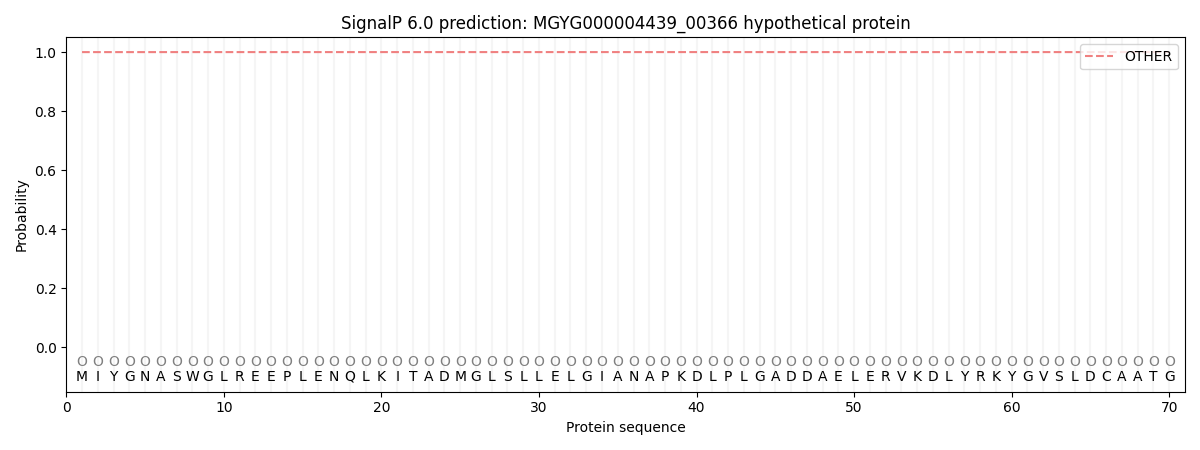You are browsing environment: HUMAN GUT
CAZyme Information: MGYG000004439_00366
You are here: Home > Sequence: MGYG000004439_00366
Basic Information |
Genomic context |
Full Sequence |
Enzyme annotations |
CAZy signature domains |
CDD domains |
CAZyme hits |
PDB hits |
Swiss-Prot hits |
SignalP and Lipop annotations |
TMHMM annotations
Basic Information help
| Species | ||||||||||||
|---|---|---|---|---|---|---|---|---|---|---|---|---|
| Lineage | Bacteria; Firmicutes_A; Clostridia; UMGS1810; UMGS1810; ; | |||||||||||
| CAZyme ID | MGYG000004439_00366 | |||||||||||
| CAZy Family | GH57 | |||||||||||
| CAZyme Description | hypothetical protein | |||||||||||
| CAZyme Property |
|
|||||||||||
| Genome Property |
|
|||||||||||
| Gene Location | Start: 33779; End: 35983 Strand: + | |||||||||||
CAZyme Signature Domains help
| Family | Start | End | Evalue | family coverage |
|---|---|---|---|---|
| GH57 | 280 | 426 | 1.5e-20 | 0.4308093994778068 |
CDD Domains download full data without filtering help
| Cdd ID | Domain | E-Value | qStart | qEnd | sStart | sEnd | Domain Description |
|---|---|---|---|---|---|---|---|
| cd10794 | GH57N_PfGalA_like | 2.30e-81 | 278 | 615 | 1 | 305 | N-terminal catalytic domain of alpha-galactosidase; glycoside hydrolase family 57 (GH57). Alpha-galactosidases (GalA, EC 3.2.1.22) catalyze the hydrolysis of alpha-1,6-linked galactose residues from oligosaccharides and polymeric galactomannans. Based on sequence similarity, the majority of eukaryotic and bacterial GalAs have been classified into glycoside hydrolase family GH27, GH36, and GH4, respectively. This subfamily is represented by a novel type of GalA from Pyrococcus furiosus (PfGalA), which belongs to the GH57 family. PfGalA is an extremely thermo-active and thermostable GalA that functions as a bacterial-like GalA, however, without the capacity to hydrolyze polysaccharides. It specifically catalyzes the hydrolysis of para-nitrophenyl-alpha-galactopyranoside, and to some extent that of melibiose and raffinose. PfGalA has a pH optimum between 5.0-5.5. |
| pfam01261 | AP_endonuc_2 | 4.12e-19 | 19 | 260 | 1 | 240 | Xylose isomerase-like TIM barrel. This TIM alpha/beta barrel structure is found in xylose isomerase and in endonuclease IV (EC:3.1.21.2). This domain is also found in the N termini of bacterial myo-inositol catabolism proteins. These are involved in the myo-inositol catabolism pathway, and is required for growth on myo-inositol in Rhizobium leguminosarum bv. viciae. |
| COG1082 | YcjR | 5.13e-18 | 1 | 265 | 3 | 268 | Sugar phosphate isomerase/epimerase [Carbohydrate transport and metabolism]. |
| cd01022 | GH57N_like | 5.11e-13 | 277 | 421 | 2 | 166 | N-terminal catalytic domain of heat stable retaining glycoside hydrolase family 57. Glycoside hydrolase family 57(GH57) is a chiefly prokaryotic family with the majority of thermostable enzymes coming from extremophiles (many of these are archaeal hyperthermophiles), which exhibit the enzyme specificities of alpha-amylase (EC 3.2.1.1), 4-alpha-glucanotransferase (EC 2.4.1.25), amylopullulanase (EC 3.2.1.1/41), and alpha-galactosidase (EC 3.2.1.22). This family also includes many hypothetical proteins with uncharacterized activity and specificity. GH57s cleave alpha-glycosidic bonds by employing a retaining mechanism, which involves a glycosyl-enzyme intermediate, allowing transglycosylation. |
| pfam03065 | Glyco_hydro_57 | 1.22e-12 | 259 | 424 | 12 | 179 | Glycosyl hydrolase family 57. This family includes alpha-amylase (EC:3.2.1.1), 4--glucanotransferase (EC:2.4.1.-) and amylopullulanase enzymes. |
CAZyme Hits help
| Hit ID | E-Value | Query Start | Query End | Hit Start | Hit End |
|---|---|---|---|---|---|
| AVM45997.1 | 2.90e-236 | 274 | 734 | 4 | 459 |
| AHF90539.1 | 3.64e-204 | 278 | 734 | 7 | 463 |
| QDT00377.1 | 8.66e-47 | 282 | 730 | 8 | 438 |
| BCW88139.1 | 1.01e-14 | 282 | 419 | 26 | 162 |
| QAZ69632.1 | 6.69e-14 | 276 | 420 | 2 | 146 |
Swiss-Prot Hits help
SignalP and Lipop Annotations help
This protein is predicted as OTHER

| Other | SP_Sec_SPI | LIPO_Sec_SPII | TAT_Tat_SPI | TATLIP_Sec_SPII | PILIN_Sec_SPIII |
|---|---|---|---|---|---|
| 1.000040 | 0.000000 | 0.000000 | 0.000000 | 0.000000 | 0.000000 |
